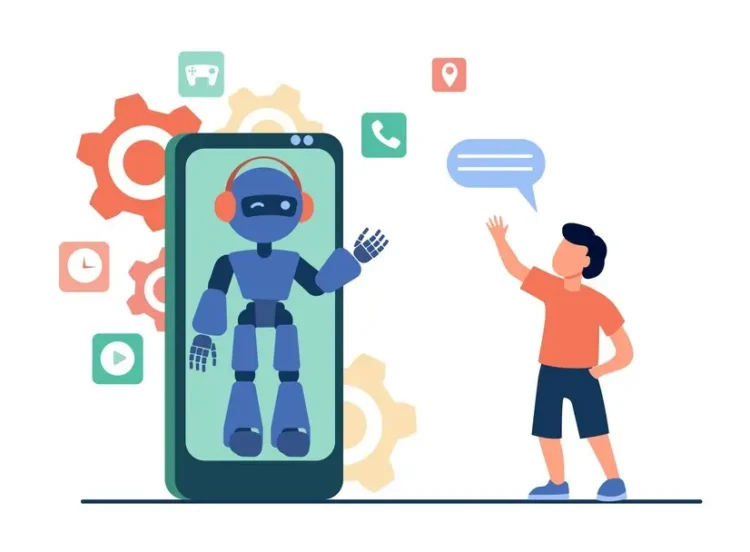Online shopping has revolutionized business-consumer interactions to be instant, convenient, and easy. With increasingly more consumers buying online, their need for instant, frictionless, and customized experience also grows. To satisfy these, companies are increasingly using AI-based chatbots. Intelligent virtual assistants are revolutionizing e-commerce customer service by providing real-time assistance, answering questions, and improving user experiences.
What are Chatbots in E-commerce?
Chatbots are software applications that employ artificial intelligence and mimic a human dialogue in written or spoken words. On shopping sites, they are virtual customer service representatives guiding customers through their own shopping experience. They employ natural language processing, machine learning, and data analytics to analyze customer queries, provide the most appropriate response, and even anticipate customer needs.
They are deployable on websites, applications, and social media and thus are an integral business tool in firms that seek to automate routines and interact more with customers.
How Chatbots Fuel E-commerce Customer Service?
Chatbots have been revolutionizing the way of eCommerce Customer Service approach. Review the key factors on how chatbots fuel Customer Service in eCommerce.
- Personalized Shopping Experience
- Status Reports and Orders
- Seamless Conversational Commerce
- 24/7 Customer Care
- Real-time Query Resolution
- Real-time Query Resolution
- Effective Refund and Return Management
- Sales Growth and Lead Generation
- Multi-Language Support
Chatbots use AI to identify customers’ buying history, behavior, and interest to recommend products to them based on their own interest. Customer products recommended by chatbots are appropriate to enhance the shopping experience, leading to increased customer satisfaction and conversion.
Chatbots provide order status, delivery, and real-time correct tracking as well. Chatbots do not need customers to navigate several pages and go to customer care for getting the order details. That is one of the reasons why post-purchase is easy for customers.
All such firms use chatbots in messaging apps like WhatsApp, Facebook Messenger, and Instagram to enable customers to explore, inquire, and buy products without ever having to return to the chat screen. Frictionless buying or conversational buying is more convenient for the consumers.
As opposed to human staff that one hires to operate shifts, chatbots are online twenty-four/seven, and that means clients can get prompt support at any time of day. That’s an extremely practical feature for multinational companies whose clients are geographically dispersed around the world.
As opposed to human staff that one hires to operate shifts, chatbots are online twenty-four/seven, and that means clients can get prompt support at any time of day. That’s an extremely practical feature for multinational companies whose clients are geographically dispersed around the world.
Today, around 80% of customer inquiries are handled by Chatbots and are highly preferred for their capabilities of instant replies to repetitive questions regarding product information, shipping policy, refund, and payment. Through responding to FAQs, the human representatives would get a chance to deal with intricate questions, and thus overall efficiency would be enhanced.
Returning and refunding usually is cumbersome. AI Chatbots make it easy by walking the customer through return policies, generating return labels, and processing refund requests effortlessly. It reduces frustration while enhancing post-purchase experiences.
Chatbots interact with leads in starting conversations, asking appropriate questions, and gathering contact details. Targeted offers and reminders follow leads, they optimize conversion and repeat business.
For international customers, the chatbots can be made to respond in more than one language, bridging language gaps and increasing the number of customers. It is a great facility for multilingual customer-facing businesses.
AI Chatbots and Rule-Based Chatbots
Online shopping robots are typically of the following two kinds:
- Rule-Based Chatbots:
- AI-Based Chatbots:
They are rule-based and provide a response based on keywords given. They are useful to reply to simple questions but lack the ability to comprehend complex questions and provide personalized responses.
These enable NLP and machine learning to understand context, read the customer’s intent, and learn with time. These enable natural conversations, and it is best to utilize these to enhance customer service for web shopping.
AI-trained bots are capable of getting the chance to learn and respond to more and better questions as per customer interaction.
Limitations and E-commerce Challenges of Chatbots
While they are very helpful, there are flaws that exist in chatbots:
- Limited Understanding of Sensitive Questions
- Limited Understanding of Sensitive Questions
- Integration Issues
- Security and Privacy Concerns
As smart as AI chatbots are, they typically don’t understand extremely sensitive or complicated questions, and a little bit of humanity might need to be added.
Some of the customers prefer to talk to a human representative, especially in a personal issue or complaint. A fully automated system of chatbots is annoying to the customer.
Firms must incorporate chatbots into current CRM, inventory management systems, and payment systems in a non-intrusive way. Poor integration would lead to inconsistent response behavior and operational inefficiency.
Because chatbots hold customer information, businesses must design robust security technology to protect privacy data and provide data privacy policy.
Future Trends in Chatbot Technology in E-commerce
The future is bright for business chatbots with artificial intelligence technologies at the vanguard of the next steps:
- Voice-Enabled Chatbots
- Sentiment Analysis for Enhanced Human Interactions
- Augmented Reality (AR) Integration
- Blockchain for Secure Transactions
- AI Virtual Shopping Assistants
With the Alexa and Google Assistant voice assistant phenomenon, e-commerce chatbots are now being made voice-enabled, giving consumers a more natural and convenient shopping experience.
The future chatbots will use sentiment analysis to ascertain the emotions of the customers and react accordingly. This will result in more empathetic and human-like dialogue.
Others among the chatbots will be blended with AR in order to allow for virtual trying-on of goods such as accessories, clothing, and makeup to boost online shopping confidence.
Blockchain chatbots will ensure security for online transactions, and customers will be more confident in online platforms.
Sophisticated chatbots will serve as individual shopping assistants, providing advanced recommendations in advance of best-sellers, previous purchases, and online history.
Conclusion
Chatbots are revolutionizing e-commerce customer support into live assistance, tailored recommendations, and convenient shopping experiences. With advancements in AI technology, chatbots will become ever smarter, and customer interaction and sales will improve. Enterprises should strike a balance between automation and human touch to achieve full customer satisfaction. By smart application of AI-powered chatbots, e-commerce businesses can outshine the competition and offer improved shopping experiences in cyberspace.
Author Bio:
Harikrishna Kundariya, is a marketer, developer, IoT, Cloud & AWS savvy, co-founder, and Director of eSparkBiz, a Software Development Company. His 14+ years of experience enables him to provide digital solutions to new start-ups based on IoT and SaaS applications.















